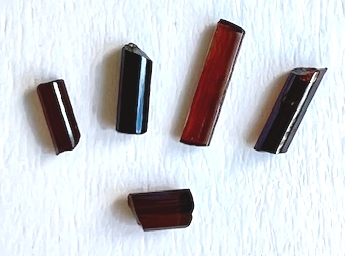Painite Visible Spectra (380 -
1100 nm) and History
Painite was once considered one
of the rarest minerals on
earth. The first painite to be recognized as new mineral (painite #1)
was a sample discovered in Burma in the early 1950's. For many years
only two crystals of this hexagonal mineral were known to exist.
Its chemical formula is ideally: CaZrBAl9O18.
However, it also contains minor amounts of chromium and
vanadium that contribute to the orange-red to
brownish-red color of the mineral plus traces of iron. In addition to
zirconium, minor amounts of titanium and hafnium also are part of its
composition. While it often appeared in
lists of gemstones, only two faceted gemstones had been reported prior
to mid-2005. This author's discovery of a new locality in northern
Myanmar in 2002, and the discovery of major new localities in
the
Mogok area led
to the recovery of several thousand crystals and fragments.
Nearly complete crystals remain few in number and high quality
facet material remains rare, although more than a hundred crystals
and pieces have been faceted to date.
The painite absorption spectrum
- GRR
417
spectrum; This spectrum was
taken from a slice of crystal #1 (British Museum 1954,192) that was
used for the original structure determination (Moore and Araki, 1976).
It was found in the gemstone fields near Ongaing, a village near Mogok,
Burma, by A.C.D. Pain. Plotted for 0.60 mm thickness. Data Files: E perp c
18K; E||c
15K.
More
About the History of Painite
Painite #1
is a 1.7 gram
crystal that resides in the British Museum of Natural History,
London (BM 1954,192). It was obtained in 1952 through a donation by
A.C.D.
Pain, and originally
described in an article by Claringbull et al in
1957. The slice of this crystal (painite #1b) that was used
for
the X-ray structure determination (Moore & Araki, 1976) and
the optical (Shigley et al., 1986) and Raman spectra is now at
the California Institute of Technology.
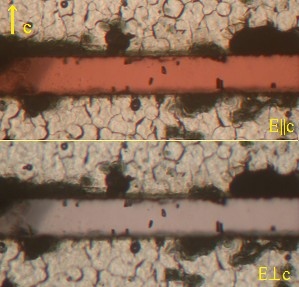 |
The dichroism of
a 0.606 mm
thick slice of painite #1b
embedded in beads of a colorless plastic shows that
the crystal
is orange-red for light polarized parallel to the c-axis
and pale
purple when polarized perpendicular to the c-axis. |
|
Chemical Analysis Painite #1 (Shigley et al,
1984)
Na2O
0.20 wt%
Al2O3
68.27
CaO 6.68
TiO2
0.83
V2O3
0.17
Cr2O3
0.25
FeO 0.05
(total iron reported as FeO)
ZrO2
17.56
HfO2
0.58
Vanadium and chromium are responsible for the color
Electron microprobe analysis: boron not analyzed |
|
Painite BM 1914,1118.
An earlier painite sample was in the British Museum of Natural History,
but was originally misidentified as a brown tourmaine with rubies from
Mogok, Burma. In late 2007,
this sample was proven to be painite by an electron microprobe
analysis. In the photo, painites #1 and #2 are also shown.
(Photo
provided by Alan Hart, British Museum of Natural History)
Painite #2
is a dark, 2.118
gram crystal on public display
in the British Museum of Natural
History, London. There are no reported detailed studies of this
crystal.
Painite #3
is a 0.27 gram
crystal now in the collection of the Gemological Institute of
America. It was discovered in 1979 at the Gemological
Institute of America (GIA) in a parcel of gemstone rough and has
been extensively studied at the GIA, at the Los Angeles County
Museum of Natural History, and at Caltech (Shigley et al., 1986).
It is a dichroic, deeply colored, brownish-orange red crystal
with a density of 4.03.
Chemical Analysis Painite #3 (Shigley et al, 1984)
Na2O
0.42 wt%
Al2O3
68.06
CaO 7.54
TiO2
1.16
V2O3
0.21
Cr2O3
0.48
FeO 0.04
(total iron reported as FeO)
ZrO2
17.66
HfO2
0.80
|
Painite #4 [updated May 2006]
was
originally ~11
grams (55 cts) when discovered in late summer, 2001, in Burma.
The identity of painite #4 was first suspected by Burmese
investigators based on its density, refractive indices and
hardness, but they did not have the necessary equipment and mineral standard to confirm their suspicions. A 0.188
gram slice (painite 4b)
was removed from it and was sent to Caltech for confirmation of
the original tentative identification where its identity was confirmed
in September, 2001. The XRF analysis showed
major Al, Ca, and Zr, and minor Ti, Fe, Hf, and Cr. The Raman
spectrum matched the standard
painite
spectrum that we acquired from
the sample of painite #1b that
was originally used to determine the crystal structure (Moore
& Araki, 1976). Even though the orientation of crystal #4b is
different, its infrared
reflectance spectrum is similar
to that of painite #1b [in
the (0001) orientation]. Slice 4b is now privately owned in the
USA. A small aliquot of 4b also resides at Caltech. A second
slab that was also removed (painite 4c) is in the US National
Museum of Natural History, Smithsonian Institution. The main mass
(painite 4a, now 54 cts) of the dark, nearly opaque crystal was
originally privately owned in Burma.
Chemical Analysis Painite
#4
Na2O
0.90 wt%
Al2O3
64.49
CaO 6.45
TiO2
2.49
V2O3
0.17
Cr2O3
0.29
FeO 0.05
(total iron reported as FeO)
ZrO2
17.60
HfO2
0.37
|
|
Painite 4a
was
subsequently acquired by the GRS Gemresearch Swisslab AG,
Switzerland. It has been the object of detailed
study at the AIGS laboratory in Bangkok, the GRS Swiss lab, and
university labs in Switzerland. A 0.030
gram fragment (painite 4d) was
removed from the main crystal
and formerly appeared at the website of the GRS
Gem
Research Swiss Lab. Detailed chemical
analyses and a redetermination of the crystal structure are reported by
Armbruster et al. (2004). Unaware that their crystal was
identical with crystal #4, Armbruster et al. stated
that the 54 ct crystal came from a new crystal which they labeled
painite #6. |
Painite #5
is a 0.508
gram faceted gemstone that was first identified by GRS (Thailand) Co.
Ltd. in Bangkok. It was studied by the GRS
Gem
Research Swiss Lab and was formerly pictured on their website. It
currently resides with its owner in Burma. (updated
26-May-2006)
Painite #6 was in a bag of lower-quality, gem rough
purchased by the
author of this web site in
Namya (Namyazeik) from a mine slightly north of the road through Chishidu, northern Myanmar, in March, 2002. After it was
brought back to the author's laboratory, it was identified from
its chemical composition and Raman spectrum. This
locality is a ruby mine far removed from the original discovery
locality at Ongaing and represents the second known locality
where painite occurs. The crystal has undergone detailed study at
Caltech.
| It was
originally identified from its
X-ray fluorescence spectrum while embedded in plastic with
corundums in a mount
prepared for analysis in a
scanning electron microscope (image to the right). It
is currently embedded in a plastic mount that was used for
electron microprobe analysis. This allows the internal
detail to
be seen. When the mount is tilted so the line of sight is down
the long axis, the symmetrical
pattern of the internal features
can be seen. |
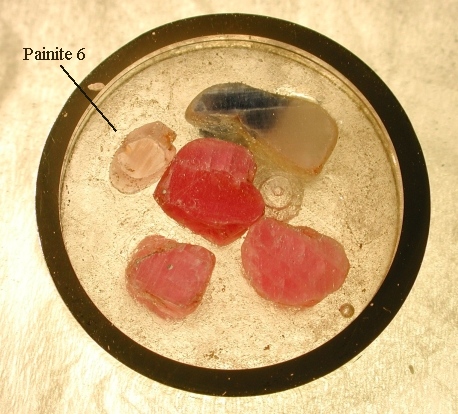 |
Chemical
Analysis Painite #6
Na2O 0.16 wt%
Al2O3
66.39
CaO 7.65
TiO2
0.75
V2O3
0.02
Cr2O3
0.04
FeO
0.00
ZrO2
17.73
HfO2
0.33
|
|
Painite #7
was also
purchased by the author of this web site in Namya, northern
Myanmar, in March, 2002, and positively identified based on its
chemical composition and Raman spectrum. This 0.0467 gram, dichroic
pale pink crystal
is in the author's collection at Caltech and has been subjected to
detailed study of its composition and optical spectrum.
This
crystal, and all other others discovered to date from the Namya
localilty, are much paler than painite crystals found at Ongaing
and other localities in the vicinity of Mogok.
Chemical
Analysis Painite #7
Na2O
0.15 wt%
Al2O3
67.81
CaO 7.92
TiO2
0.68
V2O3
0.02
Cr2O3
0.03
FeO
0.01
ZrO2
17.97
HfO2
0.41
|
Painite #8
is a
brownish-orange uniaxial crystal that was found in May, 2004,
near Ohngaing village, Mogok region, Myanmar. It was identified
as painite in Mogok by a gemologist on the basis of
standard gemological testing. The strongly dichroic crystal has a
specific gravity of 4.00. The 0.522 gram stone currently resides
in Burma. Many of the numerous small, secondary
crystals have
been removed from the edge of the master crystal and are the
object of study in Burma and at Caltech. The Raman spectrum
confirms that they are painite.The optical
spectrum of
0.809 mm thick, 2.9 mm long crystal
'8b' shows the same features as
those of crystal #1. Like the
main crystal, they are dichroic
in transmitted light with the most intense red color when light
is polarized parallel to the long c-axis of the crystal. The
outline of the crystal
shape
of fragment 8b is apparent looking down the long axis of the
crystal. As of May, 2006, the main mass of this crystal resided with the GRS in
Switzerland.
Painite #9
was offered for
sale in 2004 in Yangon, after which it went into private
ownership in Japan. It reportedly weighs about 340 mg and is an
orange-red color similar to painite #8. It is now in the collection of
the GRS in Switzerland. (updated 26-May-2006).
Painite
#10,
a
dark, brownish-orange
uniaxial
crystal was found in December, 2004, near Ohngaing village, Mogok
region, Myanmar. It was identified as painite in Mogok on the
basis of standard gemological testing. It is strongly dichroic
from brown to red. The 0.93 gram stone was orginally studied by a
Burmese gemologist and is now in the collection of the GRS in
Switzerland. (updated 26-May-2006).
Painite #11
is a dark
brown-orange crystal that was announced on
31-December, 2004. It
was identified as painite in Mogok on the basis of standard
gemological testing. It is nearly 2 cm long and about 1 cm wide.
The 2.58 gram stone currently now resides in the collection of the GRS
in Switzerland. This crystal is of particular
interest because one side of the crystal has numerous small rubies
attached. These rubies
are
abundant on the crystal. (updated 26-May-2006)
Painite #12
is an
orange-brown, 0.156 gram, transparent, uniaxial,
gemmy crystal with
one perfect termination
was obtained in Burma in 1992. At that time it was under private
ownership in Burma but its existance was only made
public years later. As such, it may be the fourth painite crystal actually
discovered.
Painite #13
is an
orange-brown, 0.264 gram, transparent, dichroic,
gemmy crystal
identified January 4, 2005, by a gemologist in Mogok. It was
found near Mogok, Burma, and is currently believed to be under private
ownership. It was offered for sale (April, 2005) partly through
advertisements on the web.
News about our discovery and
identification of painites #6 and
#7 was relayed to geologists in Myanmar in 2004. Efforts
were soon underway to find more in the northern province. Those
efforts were successful.
Painites
#14 and #15 -
Press Releases from Asia
The Associated Press/Rangoon reported on March 15,
2005 that two crystals were found near Phakant, Kachin State, Myanmar,
by geology student Kyaw Khaing Win. Phakant is near Namya where
painites #6 and #7 were obtained.
The Myanmar Times reports the discovery of the same two stones in the
Namyar region but puts the data of discovery as November, 2004. A
picture from the Yagon City website, repeating the
Myanmar Times article, shows the painite
#15
crystal.
Painite #14
is a pale
pink, 0.0727 gram, transparent, dichroic
gemmy crystal
identified in late 2004. The outline of the crystal shape
of crystal 14 is
apparent looking down the long axis of the crystal. Its identity
was positively confirmed at Caltech in early 2005 and it is
currently under private ownership in the United States.
Painite #15
is a 0.0662
gram, medium
red-brown,
dichroic
crystal,
transparent crystal identified in late 2004 or early 2005. The
outline of the crystal
shape
of crystal 15 is apparent looking down the long axis of the
crystal. Its identity was positively confirmed at Caltech in
early 2005 and it is currently under private ownership in the
United States.
Four additional painites were
positively identified by a
gemologist at the AIGS laboratory in Thailand. Additional
information
about them was previously available on the AIGS
website (broken link, 2014) .
These crystals are believed to
have been discovered in late
2004 to early 2005.
Painite #16 is a crystal that
was found in the Mogok region. (November 2005 - recent
information indicates that this is actually painite #9)
Painite #17
is a crystal that was found the Mogok region.
A 2005 article in the IRRAWADDY, a newspaper covering Burma, reported two more painites that were found in northern Burma
Painite #18
is a small gemstone faceted from a painite found in Northern Myanmar.
This is the second reported faceted painite. (See painite #5, also a
faceted stone).
Painite #19
is a small stone found in Northern Myanmar
Three
more painites were discovered in early 2005
in Burma.
The properties of these there
stones are characteristic of the
crystals that come from the Namya locality.
Painite #20
is a 0.0280 gram (0.0140 ct) pale purplish pink, dichroic
crystal fragment devoid of a termination. Looking down the c-axis,
the hexagonal shape of the crystal can be seen. There are also inclusions
in the crystal that contain brown
and red
phases within and around the longer, tubular inclusions. This crystal
is under private ownership and has been studied at Caltech.
Painite #21
is a 0.0335 gram (0.1675 ct) grayish purplish pink, dichroic
crystal fragment with comparatively fresh prism faces, but devoid of
terminations. Looking down
the
c-axis,
the hexagonal shape of the crystal can be seen. There are also
inclusions in the crystal that contain brown
and yellow
phases within and around the longer, tubular inclusions. This crystal
is currently under private ownership and has been studied at Caltech.
Painite #22
is a 0.0321 gram (0.1605 ct) pale purplish pink, dichroic,
clear crystal fragment that is devoid of terminations. Looking down the c-axis,
the hexagonal shape of the crystal can be seen. The surface of this
crystal has a tree-bark
texture that some of the other
crystals from northern Burma have. This crystal is privately owned and
has been studied at Caltech.
Much additional information
about the first 22
painites was reported in May 2005 at the Goldschmidt 2005
Conference in a session
(Page A278) on the gem minerals
(Rossman et al., 2005). The authors concluded that the mineral
forms in a
skarn deposit. After submission of the abstract, but before it
was presented at the meeting, the skarn deposit where painite
formed was located in Myanmar as reported below.
The
Painite Mine near Ongaing
December,
2004: The initial
source of painite has been claimed by local residents to be alluvial
pebbles obtained near Ohngaing
Village in Myanmar. These painites showed only modest water
rounding indicating that the primary source was nearby. The
actual source of painite near Ongaing
Village has finally been
located. Ohngaing
Village is slightly more than a mile NNW
of Mogok.
From Ohngaing Village one can see Mogok
in the distant
valley in this picture. Painite was reported to found at a small mine
just at the edge of
Ohngaing known as the Sinhalite
Mine. The mine produces mostly
spinels of assorted colors,
tourmaline and sinhalite. The mine doesn't produce any
gem-quality corundum. Painite is said to be found in the
upper portion of the mine near the contact of leucogranite and marble
in weathered soil.
Subsequent exploration of the
geological formation has greatly
expanded the region where painite is found as indicated in the
paragraphs below.
Painite #23
is a 4.8 mm
long, 0.9 mm wide intergrowth of two crystals (estimated weight,
0.03 grams) in a matrix of rubies, rutile, and fine-grained clay
minerals including anatase and iron oxide. It is weakly dichroic
from
reddish-brown to yellow-brown but the dichroism is hard to see
because of darker inclusions in cracks in the specimen. It was
reported in late May, 2005. It's identity was confirmed from its
Raman spectrum. It is currently under private ownership and has
been at Caltech for confirmation of the identification, but was
not removed from the host matrix. Its color and properties
indicate that it originated in the deposits in the Mogok
district.
Painite #24 is also a crystal
on matrix that was shown in
Yangon in May, 2005. No further details are available at this
time.
June,
2005.
Painite 25
is an approximately 2 cm long crystal in a matrix of a skarn rock
containing ruby and biotite. The crystal
has a dark color typical of crystals discovered so far in the Mogok
region. The locality is west of Mogok, near Kyaukpyatthat (Kyauk Pyar
Thart). They are found at the Wetloo quarter near the base of Hinthar
Hill where they form at the contact zone of leocogranite and marble.
Once the actual source was known, an extensive effort was made to find
more painites from the Mogok deposits. These efforts were comparatively
successful resulting in a plentiful supply, at least compared to early
2005.
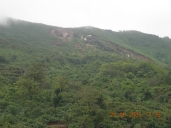
The Wetloo
Mine on Hinthar Hill; painite
occurs at the contact zone near the base of the hill.
A
note to the readers of this page.
With the new discoveries, painite became
more abundant, Further numbering
of specimens beyond number 25 was not justified and
was discontinued at this web
site. Pictures of new specimens will continue to be posted when
they are of particular merit, crystal perfection or beauty, or if
they have been the object of detailed scientific investigation.
Mid
July, 2005.
Within one week of the
discovery of painite at Wetloo, Painite
was found east of Mogok
very close to Thurein-taung
(painite locality = number 1 in photo; village = number 2) at Ah
Sein Taw Quarter. Many fragments and crystals of painite
have been found there.
Nearly every home there had painite for sale. Most are mineral specimen
quality. Some
can be cut to a cabochon and only a few are suitable for
faceting. This locality is also known as Thu-Rein-Thaung
and as Sun Mountain. The painite occurs in a skarn deposit in contact
with leucogranite.
Late July, 2005
Numerous painites were
available in the local gem and mineral markets.
a) 0.08
ct transparent
crystal
b) 53 ct nearly opaque
crystal
c) 0.226 ct terminated
crystal
d) 0.2 to 0.5 ct crystals
and
fragments
Smaller, secondary
deposits
have also been located in the area that further increase the
supply of painite.
Larger
quantitites available in late August, 2005
Numerous fragments
of painite
crystals have been discovered as a result of extensive efforts to
sluice the entire area where painite occurs. Most of these were
sent to Thailand for processing and sale. Most of them were
purchased by the company, Pala
International. Most of them came
from the Wetloo Mine and
others came from the Thurein-taung locality.
a) 36.5 grams of crystal
fragments
b) 120 grams of fragments
A few incomplete, dark crystals exceeding several hundred carats
have been found.
c) 107 gram crystal
d) A 96 gram specimen of a crystal with
smaller crystals
attached.
Fine specimens exist, but are rare.
e) An 8.2 ct crystal
from the Wetloo
Mine
f) three nice
crystals all
less than 1 cm long
Also, crystals both large and small, have been found with ruby
attached
g) 40 gram crystal partially
covered with small rubies
h) painite
and ruby
in matrix
While many pieces have been cut into dark red cabochons, facet
quality material is said to remain almost unattainable.
i) 10 cts, Thurein Taung locality, small, crystals
j) 5 cts, nodules of facet
quality
Matrix
specimens with
abundant painite fragments have also been obtained.
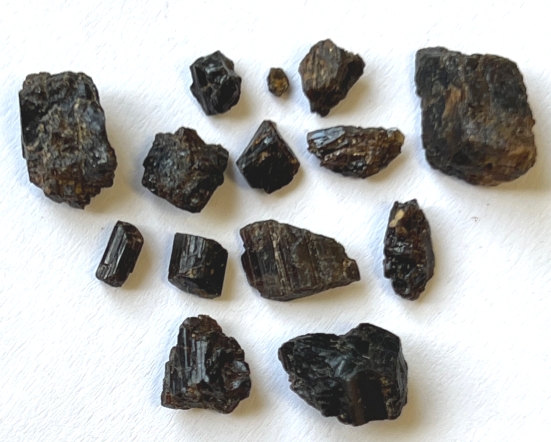
Painites from the Mogok region, August 2005
Further
information (early October 2005)
A number of small faceted stones have been prepared from the
recently discovered highest quality stones. A picture of the
three largest new faceted stones, and more history about the
recent stones is available on the website of Palagems.
As of
the second week of October, 2005, specimens of painite and
faceted stones have been available for sale on the internet at
several sites.
Museum
Painites (late October 2005)
A
number of crystals and faceted
stones have been obtained by major museums and are expected to
soon be on public display. The Los Angeles County Museum of
Natural History has a 4.9 mm (0.47 ct) faceted stone.
Both
the National Museum of Natural
History - Smithsonian Institution, and the American Museum of
Natural History
have also obtained examples of painite.
More
crystals (mid November 2005)
About
700 crystals and two faceted
stones were brought to the Asian Institute of Geomological
Sciences in Bangkok by a Burmese dealer. Details were posted on
the AIGS
website.
A New Locality for Painite - Bawlonegyi Painite
Mines
(early December 2005)
Painite
is now found in the Bawlonegyi area due west of Mogok. The crystals are
small in size and have a color similar to the painites from the Wetloo
mine with six sided crystals. They have been found only in secondary
deposits, to date. Here
are pictures taken in mid December 2005 of Bawlonegyi
Palaung Village and a miner panning
for painite.
Thurein
Taung Painite Mine (Mid December, 2005)
Wetloo
Painite Mines (Mid December, 2005)
Here are pictures of painite
from the Wetloo
painite Mines, a different
view
of the workings, and the local
area. Here is the
mine in spring 2006.
New Localities for Painite (December, 2005)
Painite has been reported
from both Kin and Kabaing,
two villages west of the
other Mogok region localities.
Tucson
Mineral Show (Early February, 2006)
Painites were for sale at the
Tucson Mineral show.
From the GemResearch Swiss
Lab (May 2006)
The GemResearch Swiss Lab
reports the
discovery of the largest
painite specimen to date weighing 633 grams (3,165 cts).
Found in mine tailings, it is a large, lusterous painite
crystal overgrown with numerous rubies.
Painite in
Matrix (May 2006)
A 5 mm crystal
in matrix. Another
crystal in matrix with spinels. A 1 cm crystal
in matrix with excellent crystal faces. A 4.5 cm crystal
of painite mostly replaced by ruby; a closeup of a
painite region. Additional pictures: a lusterous 26.3 gram painite with
prominent red spinel. A 4.5
cm crystal and a 4.4
cm crystal pair. A painite crystal
with hexagonal
shape.
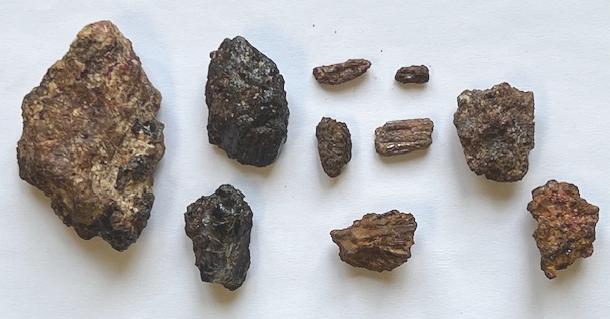
Painites obtained late 2005-mid 2006 mostly from the Wet Loo Mine
Painite crystal from
Namya (Sep 2006)
A
0.52 carat pink
crystal of painite from Namya was obtained by Pala
International.
Painite at the Tucson
show (Feb 2007)
Faceted Painite (May 2007)
A 3.8
carat, dark red painite was obtained by Pala International.
The Wet Loo Mine in 2013
By 2013
the deposit
(image courtesy of George Harlow, American Museum of Natural History)
was mined out and partly overgrown. The active mine was in a skarn
deposit between the Mogok Marble and the Kabaing Granite. Now the
mined-out deposit is a deep creek bed.
Update from Myanmar: December 2020
a)
Painite was found mainly at two localities, Wet Loo
and Thurein Taung.
Lesser amounts were found in Baw Lone Gyi, in the
northwest part of Hin Thar Taung.
Some miners
searched for painite in a contact zone of marble and
leucogranite in Hin Thar Taung, located at the upper side of Wet Loo
mine
They found small samples of painite with ruby in marble
matrix in past year.
Some people thought that may be primary but it is
only in the trend of the contact zone.
Samples were of
mineral specimen quality but not suitable for gems.
b) In Myanmar, few
gem quality painites were available in the gem markets, but a few older
stones from the mid 2000's were available.
They brought high prices in
the past five years.
c) New samples of
Namya painites have not been available as the large mines are closed
and only informal mining occurs.
d) Likewise, in
Mogok, only informal mining was occuring and that was directed at high
value stones such as ruby, sapphire and spinel.
References:
Armbruster T, Döbelin
N, Peretti A, Günther D, Reusser E,
Grobéty B (2004) The crystal structure of painite CaZrB[Al9O18]
revisited. American Mineralogist 89, 610-613.
Claringbull GF, Hey MH, Payne
CJ (1957) Painite, a new mineral
from Mogok, Burma. Mineralogical Magazine 31, 420-5.
Harlow GE, Bender W (2013) A study of ruby (corundum) compositions
from the Mogok Belt, Myanmar: Searching for chemical fingerprints.
American Mineralogist 98, 1120-1132.
Hart A, Rumsey M (2014) A wonderfully 'painful'
discovery. The Journal of Gemmology 34, 10-11.
Makovicky E, Olsen LA (2008) High-pressure Al-rich hexagonal
phases—What are their kin? American Mineralogist 93, 1585-1587.
Moore PB, Araki T (1976)
Painite, CaZrB[Al9O18]:
Its crystal structure and relation to jeremejevite, B5[[]3Al6(OH)3O15],
and fluoborite, B3[Mg9(F,OH)9O9].
American Mineralogist 61, 88-94.
Nissinboim A, Harlow GE (2011) A study of ruby on painite from
the Mogok Stone Tract: Gems and Gemology, Research Track, Gem
Localitiesand Formation, 47, 140–141.
PalaGems.com (2014) Painite Comes to Pala. https://www.palagems.com/painite.htm pdf file
Peretti A (2003) Rare gemstone:
painite. Contributions to
Gemology. Gem Research Swiss Lab. 2, 19-20.
Povarennykh AS, Clark AM, Jones
GC (1978) The infrared
spectrum of painite. Mineralogical Magazine 42, 518-19.
Rossman GR, Naung S, Harlow GE,
Hunt J (2005) Painite (CaZrBAl9O18):
A second source in Myanmar and metasomatic origins. Abstract.
Goldschmidt Conference 2005, Moscow, ID. Geochimica et
Cosmochimica Acta 69, A278.
Rossman GR (2006) New discoveries of painite in Myanmar
(Burma). Gems & Gemology 41, 356.
Shigley JE, Kampf AR, Rossman
GR (1986) New data on painite.
Mineralogical Magazine 50, 267-70.
Thu,
K. (2007) The igneous rocks of the Mogok Stone Tract: Their
distributions, petrography, petrochemistry, sequence, geochronology and
economic geology, 139 p. Ph.D. thesis, Yangon University, Yangon,
Myanmar. (p 125–126)
 Back
to the list of minerals
Back
to the list of minerals
 Back
to the Index of Data Files
Back
to the Index of Data Files
 Back
to the
Mineral Spectroscopy home page
Back
to the
Mineral Spectroscopy home page
updated 10-Oct-2025
© George R. Rossman





